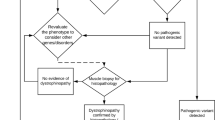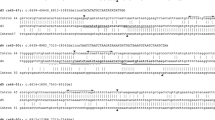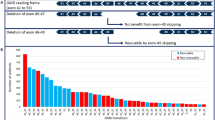Abstract
Duchenne muscular dystropy (DMD) is an X-linked disorder affecting about 1 in 3,500 males1,2. It is allelic with the milder Becker muscular dystrophy. The biochemical basis for both diseases is unknown and no effective treatment is available. Long-range physical mapping has shown that the DMD gene, localized in Xp21, is extremely large2–6, exceeding 2 million base pairs7. Until now, carrier detection and prenatal diagnosis has involved the use of linked restriction fragment length polymorphism markers8,9 which detect muscular dystrophy-associated deletions in about 10% of the cases10–12. Field inversion gel electrophoresis (F1GE) allows the detection of structural rearrangements in 21 out of 39 of the DMD patients studied (54%), of which 14 (65%) were not detected by conventional methods. Large deletions seem to make up a much higher fraction of the DMD mutations than so far indicated by other methods. A region prone to deletion was located in the distal half of the gene. FIGE analysis could provide a valuable extension of information for carrier detection and prenatal diagnosis. The technique should be generally applicable to the study of diseases involving structural chromosomal rearrangements.
This is a preview of subscription content, access via your institution
Access options
Subscribe to this journal
Receive 51 print issues and online access
$199.00 per year
only $3.90 per issue
Buy this article
- Purchase on Springer Link
- Instant access to full article PDF
Prices may be subject to local taxes which are calculated during checkout
Similar content being viewed by others
References
Moser, H. Hum. Genet. 66, 17–40 (1984).
Monaco, A. P. & Kunkel, L. M. Trends Genet. 3, 33–37 (1987).
Monaco, A. P. et al. Nature 323, 646–650 (1986).
Burmeister, M. & Lehrach, H. Nature 324, 482–485 (1986).
Van Ommen, G. J. B. et al. Cell 47, 499–504 (1986).
Kenwrick, S., Patterson, M., Speer, A., Fischbeck, K. & Davies, K. Cell 48, 351–357 (1987).
van Ommen, G. J. B. et al. Genomics (submitted).
Wieacker, P., Davies, K. E., Pearson, P. L. & Ropers, H-H. Lancet ii, 1325–1327 (1983).
Bakker, E. et al. Lancet i, 655–658 (1985).
Monaco, A. P. et al. Nature 316, 842–845 (1985).
Kunkel, L. M. et al. Nature 322, 73–77 (1986).
Monaco, A. P., Bertelson, C. J., Colletti-Feener, C. & Kunkel, L. M. Hum. Genet. 75, 221–227 (1987).
Bakker, E. et al. J. med. Genet. 23, 573–580 (1986).
Carle, G. R. & Olson, M. V. Nucleic Acids Res. 12, 5647–5664 (1984).
Carle, G. R., Frank, M. & Olson, M. V. Science 232, 65–68 (1986).
Fischbeck, K. H. et al. Lancet ii, 104 (1986).
Koenig, M. et al. Cell 50, 509–517 (1987).
Burghes, A. H. M. et al. Nature 328, 434–437 (1987).
Ray, P. N. et al. Nature 318, 672–675 (1985).
van Ommen, G. J. B. & Verkerk, J. M. K. in Human Genetic Disease, A Practical Approach (ed. Davies, K. E.) 113–133 (IRL, Oxford, 1986).
Author information
Authors and Affiliations
Rights and permissions
About this article
Cite this article
den Dunnen, J., Bakker, E., Breteler, E. et al. Direct detection of more than 50% of the Duchenne muscular dystrophy mutations by field inversion gels. Nature 329, 640–642 (1987). https://doi.org/10.1038/329640a0
Received:
Accepted:
Issue Date:
DOI: https://doi.org/10.1038/329640a0
This article is cited by
-
Dystrophin Isoform Induction In Vivo by Antisense-mediated Alternative Splicing
Molecular Therapy (2010)
-
Structural analysis of DMD gene and its clinical application in Chinese.I.Bgl II exon-containing fragment, RFLP and carrier detection
Cell Research (1994)
-
A refined restriction map of YAC clones spanning the entire human dystrophin gene
Mammalian Genome (1994)
-
The dystrophin superfamily: variability and complexity
Journal of Muscle Research and Cell Motility (1994)
-
A 400-kb tandem duplication within the dystrophin gene leads to severe Becker muscular dystrophy
Journal of Neurology (1994)
Comments
By submitting a comment you agree to abide by our Terms and Community Guidelines. If you find something abusive or that does not comply with our terms or guidelines please flag it as inappropriate.



